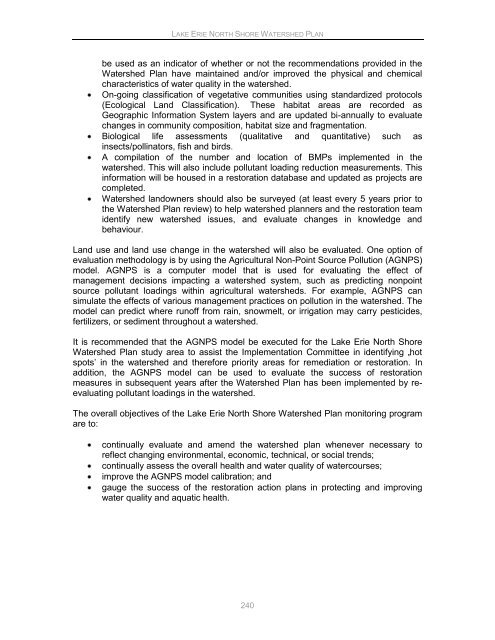Lake Erie North Shore Watershed Plan - Niagara Peninsula ...
Lake Erie North Shore Watershed Plan - Niagara Peninsula ...
Lake Erie North Shore Watershed Plan - Niagara Peninsula ...
Create successful ePaper yourself
Turn your PDF publications into a flip-book with our unique Google optimized e-Paper software.
LAKE ERIE NORTH SHORE WATERSHED PLAN<br />
be used as an indicator of whether or not the recommendations provided in the<br />
<strong>Watershed</strong> <strong>Plan</strong> have maintained and/or improved the physical and chemical<br />
characteristics of water quality in the watershed.<br />
On-going classification of vegetative communities using standardized protocols<br />
(Ecological Land Classification). These habitat areas are recorded as<br />
Geographic Information System layers and are updated bi-annually to evaluate<br />
changes in community composition, habitat size and fragmentation.<br />
Biological life assessments (qualitative and quantitative) such as<br />
insects/pollinators, fish and birds.<br />
A compilation of the number and location of BMPs implemented in the<br />
watershed. This will also include pollutant loading reduction measurements. This<br />
information will be housed in a restoration database and updated as projects are<br />
completed.<br />
<strong>Watershed</strong> landowners should also be surveyed (at least every 5 years prior to<br />
the <strong>Watershed</strong> <strong>Plan</strong> review) to help watershed planners and the restoration team<br />
identify new watershed issues, and evaluate changes in knowledge and<br />
behaviour.<br />
Land use and land use change in the watershed will also be evaluated. One option of<br />
evaluation methodology is by using the Agricultural Non-Point Source Pollution (AGNPS)<br />
model. AGNPS is a computer model that is used for evaluating the effect of<br />
management decisions impacting a watershed system, such as predicting nonpoint<br />
source pollutant loadings within agricultural watersheds. For example, AGNPS can<br />
simulate the effects of various management practices on pollution in the watershed. The<br />
model can predict where runoff from rain, snowmelt, or irrigation may carry pesticides,<br />
fertilizers, or sediment throughout a watershed.<br />
It is recommended that the AGNPS model be executed for the <strong>Lake</strong> <strong>Erie</strong> <strong>North</strong> <strong>Shore</strong><br />
<strong>Watershed</strong> <strong>Plan</strong> study area to assist the Implementation Committee in identifying „hot<br />
spots‟ in the watershed and therefore priority areas for remediation or restoration. In<br />
addition, the AGNPS model can be used to evaluate the success of restoration<br />
measures in subsequent years after the <strong>Watershed</strong> <strong>Plan</strong> has been implemented by reevaluating<br />
pollutant loadings in the watershed.<br />
The overall objectives of the <strong>Lake</strong> <strong>Erie</strong> <strong>North</strong> <strong>Shore</strong> <strong>Watershed</strong> <strong>Plan</strong> monitoring program<br />
are to:<br />
continually evaluate and amend the watershed plan whenever necessary to<br />
reflect changing environmental, economic, technical, or social trends;<br />
continually assess the overall health and water quality of watercourses;<br />
improve the AGNPS model calibration; and<br />
gauge the success of the restoration action plans in protecting and improving<br />
water quality and aquatic health.<br />
240
















